Critique Submissions
This page contains selected July 2001 submissions from photographers who wished to have their photographs reviewed by the publisher of this site,Michael Reichmann, as well as by other readers on ourDiscussion Forum.
Because of the large volume of submissions, as the month progresses you will find that this page loads slowly. Be patient.
For details on how to submit a photograph for critique please see theCritique / Contestpage.
Chris VenHaus
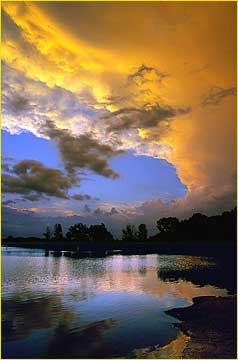
Chris VenHaus
Waukesha WI USA
drmr@execpc.com
Canon A2E , Canon 24mm f2.8 , Fuji Velvia , f5.6
I took this shot after a VERY nasty storm (I was huddled in an open shelter while it was going on). I was amazed to see the Mammatus clouds forming at the back-end of the front and was lucky enough for the rain to stop long enough for me to catch the wonderful light on the clouds. My composition options were somewhat limited due to the fact that county workers were raking the beach in a cleanup effort. The slide is very contrasty, and I did the best I could to get the color correction close to the slide, but in the end I could not get the yellows exact without mucking up the other colors (I used a Minolta Scan Speed w/Vuescan software). The yellows in this picture should be a little less bold, but they’re not that far from the slide. I used the levels adjustment independently from the horizon up and the horizon down to better match the slide. The 2 poles sticking out of the water in the background are actually water buoys.
Michael’s Critique
Wow. The contrast of the low dark clouds against the saturated yellows of the higher levels is really quite compelling. The center silhouetted coastline works as well. I’m a little less happy with the foreground. I think that the composition would be helped by cropping of the bottom 15% of the frame. Overall though, well seen and well executed.
You can add your own comments onChris’ photograph on the Critique section of ourDiscussion Forum.
Pascal Jappy
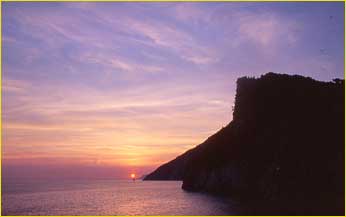
Pascal Jappy
Aubagne, France
pascal.jappy@hummingbird.com
The picture was taken from Portovenere, along 30 mile long West-North-West cliffs, seconds before sunset. A few days later, the sun was setting behind the hills on the right. I returned to this point every night and the sky was always overcast. But one evening the clouds on the horizon broke up in the final minutes of daylight and the sun gave them a texture and colour that made them look like early spacecraft images of Jupiter (at least, I think so 🙂
The camera used was a Nikon F801 with a battered 28mm sigma lens, the film is Fuji Velvia and the scanner an Epson 1640. The birds on the right were copied from another picture.
Michael’s Critique
This is a pleasant composition but ultimately leaves me a bit flat. I think that Pascal might have thought so as well since he felt compelled to superimposed the birds. It has a lot of the right ingredients but it doesn’t come to life, possibly because the cliffside silhouette isn’t strong enough and the balance of the various components is week.
You can add your own comments on Pascal’s photograph on the Critique section of ourDiscussion Forum.
Vincent Soden
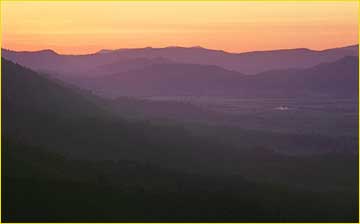
Vincent Soden
London, UK
vince_soden@hotmail.com
Everyone does the long telephoto compressed mountain range thing. Here is my attempt. One dawn in South Wales, my attention was drawn to the fact that the layers were graduated by colour as well as brightness, emphasising the layering effect. Camera was Nikon F4 with 300mm lens, using Provia, on my Gitzo tripod fitted with my new Kirk ballhead.
Michael’s Critique
This frame doesn’t work as well as it might have. There simply aren’t enough mountain variations to create a convincinglayered landscape,and the palette is too restricted. The amorphous foreground also doesn’t aid the composition.
You can add your own comments on Vincent’s photograph on the Critique section of ourDiscussion Forum.
Keiko Hayes
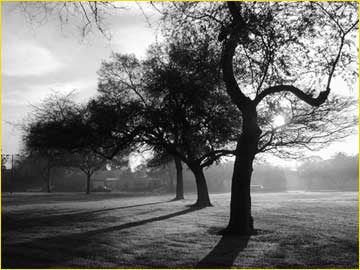
Keiko Hayes
Long Beach, CA
shakenbake13@go.com
Photograph was taken with an Olympus D490Z.
This was originally taken in color, but converted to B&W. A park bench was in the original, but later removed. Photo is not a composite. This photograph was taken at a local park in Long Beach, CA early morning. I am a novice photographer with little knowledge past high school photography club instruction.
Michael’s Critique
There is a strong mood to this frame. For a typical park scene it is well visualized and executed. Keiko might have moved a bit closer though to eliminate the distracting branches at the top left of frame and tighten the composition just a bit.
You can add your own comments on Keiko’s photograph on the Critique section of ourDiscussion Forum.
Phil Goble
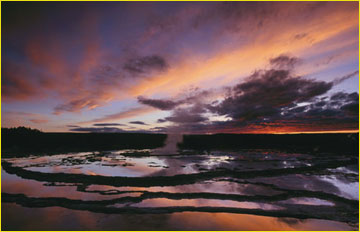
Phil Goble Champaign, Illinois, United States email:philgoble@home.comNikon F100, Nikon 17-35mm 2.8D lens (25mm), Fuji Velvia, f8 @ 1/6 sec I returned from a ten day trip to Grand Teton / Yellowstone last week. During that ten day period there were 2 or 3 evenings with interesting sunsets (snow and rain also occurred). I had gone to Great Fountain Geyser in Yellowstone three nights in a row hoping for something other than an overcast sky. The last night of the trip I took this photograph. Great Fountain was due to erupt within 1-2 hours, so the water levels had reached a point where Great Fountain was acting as a mirror. I took two rolls of this scene with different perspectives as the colors changed. Although Velvia exaggerated the colors, the actual sunset was close to the colors shown here. I wish those viewing the photograph could have actually been there.
Michael’s Critique
Obviously a very strong frame where one of the things that makes it work as well as it does is that ones eye keeps moving around the frame‚ there’s so much going in. As lovely as it is though it lacks a focal point; there possibly too much going on. Imagine it with a pinpoint of light where the setting sun must have been seconds before. That would have anchored it.
You can add your own comments on Phil’s photograph on the Critique section of ourDiscussion Forum.
Leigh Perry
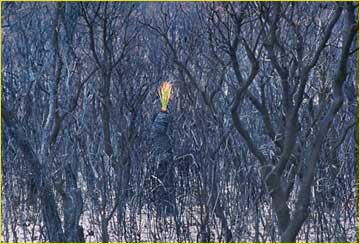
Leigh Perry
Sydney, Australia
lperry@breakpoint.com.au Provia 100F, Canon 100-300USM lens, Canon EOS 50.
Digital processing: levels, selective unsharp masking. Taken two days after a bushfire in the Stirling Ranges. Only a few grasstrees such as this one survived. A larger version can be viewed athttp://www.breakpoint.com.au/images/largeImage.asp?ImageName=Stirling-Ranges-grasstree.jpg
Michael’s Critique
It takes a while to digest what one is seeing here. I really like the shock of colour in the essentially blue field of branches, but beyond the initial "What am I looking at?" there isn’t much to hold my interest.
You can add your own comments on Leigh’s photograph on the Critique section of ourDiscussion Forum.
Ken Durling
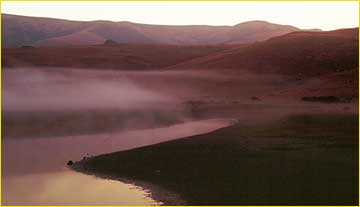
Ken Durling
Berkeley, California
"Pt. Reyes lake at dawn – Summer."
Canon Elan 7/EOS 33 with EF 28-135 f/3.5-5.6 IS on tripod Fuji Velvia, f/5.6 @ 1.5 sec
This was taken just before dawn on June 16, 2001 near the intersection of Nicasio Valley Rd and Petaluma Rd in the world famous Pt. Reyes National Seashore, an areas that despite 30 years of exploration never ceases to enchant and surprise me. Especially when I manage to get up early enough to make the 1-hour drive to get there before dawn!
Michael’s Critique
There’s a lot that works well in this photograph. The colours are muted and subtle, and the composition flows nicely. Regrettably it lacks a focal point‚ something to draw my eye. I keep scanning the frame and feeling like I want to land somewhere, but there’s nowhere in the frame that can act as an anchor.
You can add your own comments on Ken’s photograph on the Critique section of ourDiscussion Forum.
Paul Sumi
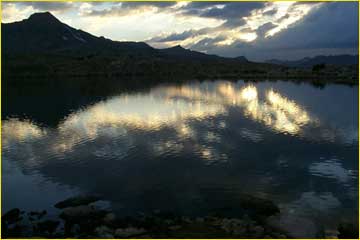
Paul Sumi
Los Angeles, CA USA
paulsumi@yahoo.com
Kodak DC-260 digital camera
Taken after a storm in California’s eastern Sierra Nevada mountains.
Michael’s Critique
Paul has wisely chosen to place the shadow area and reflection in the dominant part of the frame. The reflection is more interesting than the sky and mountain themselves, and the dark area at the bottom adds enough weight to the composition so that the mountains at the top don’t seem unbalanced. In other words, a creative and well executed composition.
You can add your own comments on Paul’s photograph on the Critique section of ourDiscussion Forum.
Thomas W. Earle
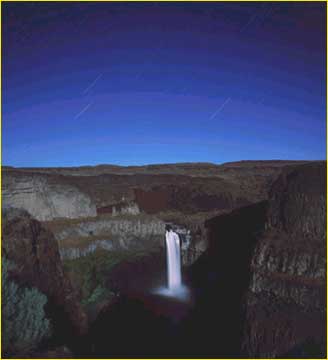
Thomas W. Earle Pendleton, Oregon (USA) Email: twade@bmi.netProvia 100F @ ASA 100 Exposure: 22 min @ f/5.6 , Camera: Petax 67 Lens: 45 mm This photograph was taken in Pallouse Falls State Park, near Starbuck, Washington. The photo is a picture of Pallouse Falls. What is unique about the photo is the fact it was taken at night. It is a 22 minute photo taken from 1230 AM to 1252 AM. At the time, the moon was 76% illuminated. Next time I try this shot, I will try a quarter moon for several hours in hopes of eliminating some of the harsh shadows. However, this may prove difficult as the canyon walls plummet 200 feet to the Pallouse River.
Michael’s Critique
Firstly, the tonality problems in the sky are caused by too much JPG compression and aren’t part of the image. Secondly, while this isn’t a compelling image, it’s fun and informative to view.
A lot of photographers do what I call "drive-by shooting". If it’s there, and a camera is at hand they take the shot. This makes the type of effort that Wade has put into this photograph all the more commendable.
You can add your own comments on Wade’s photograph on the Critique section of ourDiscussion Forum.
David Daugherty
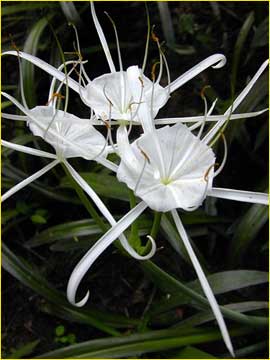
David Daugherty
Panama City, FL
david@PanamaConsulting.com
Taken with a Nikon Coolpix 950
I found these spider lilies in bloom on the Chipola river, at the end of May. I had never seen them before, and had to lookup in a guidebook to find out what they are, but they seemed to be very dynamic. I tried for a composition that would bring across the dynamic aspect. Shown full-frame, with no retouching other than color balance and a little sharpening (levels and unsharp mask).
Michael’s Critique
I don’t usually publish submitted flower pictures on this page because after a while I’d run out of things to say about them. In this case though I’ll break the rule because David has found a lovely subject, composed it very well, and nicely executed it technically. There’s little to fault here and much to enjoy.
You can add your own comments on David’s photograph on the Critique section of ourDiscussion Forum.
Thomas Nash
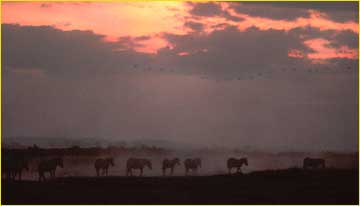
Thomas Nash
Warrenville, IL, USA,
tomnash@ameritech.net
Amboseli, Kenya, 1983. Nikon F3, Nikkor f 1.4 lens, wide open at something like 1/8 sec on High Speed Ektachrome (400 ASA), hand held leaning on the roof of the 4WD. We had arrived in the area a few hours earlier and were immediately so taken by the sight of the huge herds parading on the plain in front of Kilimanjaro that we didn’t move until it got too dark to see. In the dusk we headed out and soon came upon these zebras moving slowly through the dust away from the plains, presumably to a water hole where they would spend the night. A larger version can be seen at http://homepage.mac.com/thomasnash/ZebrasCopyright2001TNash.jpg
Michael’s Critique
The elements for a great wildlife shot are here, but I’m somehow unmoved. I find myself straining to see into the shadow areas and the flock of birds just doesn’t have the definition against the dark clouds to really complete the composition. Possibly with a lot of work on the computer this could be raised to a higher level of appeal.
You can add your own comments on Thomas’ photograph on the Critique section of ourDiscussion Forum.
Michael Fanelli
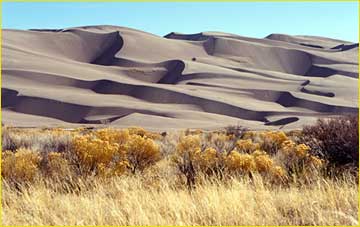
Michael Fanelli
Golden, Colorado/USA
mwfanelli@usa.net
Pentax 67, 105mm, Fuji Provia
Taken in early spring at the Great Sand Dunes National Monument in Colorado. I wanted something a bit different than the usual dunes image. The "layers" of color and textures caught my eye.
Michael’s Critique
This one immediately caught my eye. The juxtaposition of textures, colours and patterns between the four major "layers" is highly effective. I’m a little distracted by the out-of-focus stalk in the lower right, and the different coloured bush above it disturbs the perfect symmetry, but overall this is a very likeable and strong image.
You can add your own comments on Michael’s photograph on the Critique section of ourDiscussion Forum.
Dennis McKenzie
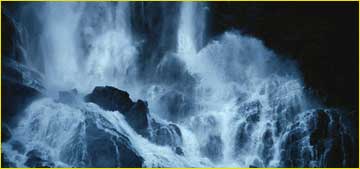
Dennis McKenzie
Wasilla, Alaska, USA
djmckenzie@webtv.net
Technical Data: camera, Nikon F4s, using Nikon 80-200mm ED f/2.8 lens with 2x Sigma converter, Film: Provia F 100 pushed to 200 ISO. Shot wide open at 5.6 from very small boat. The image was worked in Photoshop very little for levels and very little else (can’t remember) brightness and contrast most likely.
Situation: While motoring around the northend of Harriman Fjord the other year in our sailboat’s tender, an Avon ten footer. This very large waterfall was raging its way down the high sided fjord from the ice fields 100’s and 100’s of feet above the surface of the water. What a sight! So using the above gear with a Bush Hawk shoulder stock and a Gitzo tecker monopod attached to the Bush Hawk jammed into a corner of the dingy I took a series of images from our drifting boat. In this shot I like the frozen movement of the white water conterpointing the black rocks showing the fury of the falls. Creating a more abstract image.Michael’s Critique
While I immediately understood what I was seeing, what captures me here is the almost totally abstracted nature of the composition. But, I really feel the power of the falls and the coldness of the water. Very nicely done.
You can add your own comments on Dennis’ photograph on the Critique section of ourDiscussion Forum.
Ugo Mellone
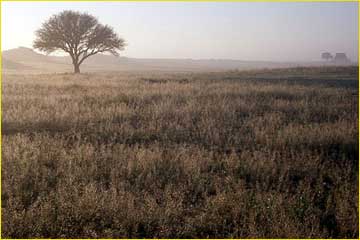
Ugo Mellone
Lecce, Italy
ugomellone@libero.it – http://www.wildphoto.it
Canon EOS 50E on tripod – 28-80/3,5-5,6 at f22 – Elitechrome 100
Taken a few minutes after sunrise. I saw the two elements, the tree on the left and the little rural building with another tree on the right and I moved in order to fill the frame with them on the background. This is one of the first photos that I have taken with reflex camera.
Michael’s Critique
This is a well composed and interesting photograph for a variety of reasons. The trees, barn and distant hills draw the eye, and the patterns in the grass provide somewhere for the eye to subsequently roam. But, I can’t help but think that this would be much more interesting as a monochrome image. Especially if the contrast were boosted to make the grass patterns more prominent.
You can add your own comments on Ugo’s photograph on the Critique section of ourDiscussion Forum.
Barry Hinschen
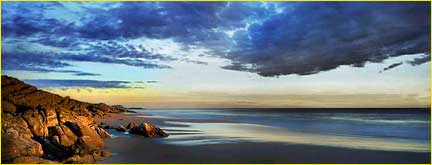
Barry Hinschen
Sheffield, UK
barryhinschen@hotmail.com
GX617 on Provia 100F.
Daybreak at Strathdickie Beach on Deliverance Island. I often notice that with the panoramic, photographers are able to use a composition that we just wouldn’t get away with in a normal rectangular or square format. I wonder if that is true in this shot?
Michael’s Critique
What works well here is the counterpoint between the warm sunlight on the cliffs at lower-left and the dark blue-black of the clouds in the upper-right. As to Barry’s question; while this works nicely as a wide-format image the right one quarter of the frame could be removed without adversely affecting the strength of the composition. I find that I have to be merciless when establishing cropping on my shots taken with either the Fuji 617 or the XPan, both of which have a 3:1 ratio. I don’t want to give anything up, but frequently 3:1 is simplytoowide.
You can add your own comments on Barry’s photograph on the Critique section of ourDiscussion Forum.
Steve Bromley
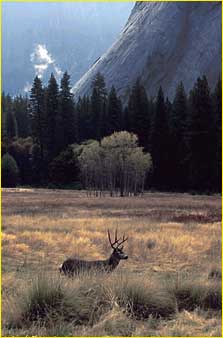
Steve Bromley
Austin, TX USA
Sbrom@austin.rr.com
"Morning Deer" Yosemite Valley – November, 2000
Canon Elan II, 100-400L lens at 300mm, f8. Kodak E100VS film. Scanned with Nikon 4000ED, adjusted in Photoshop to match the original. This deer was conveniently wandering in the Awahnee meadow as morning light began streaming around the canyon wall. I liked the contrast between the muted colors of the foreground and the whispy light. If I had it to do over, I’d try changing positions to emphasize the diagonal of the canyon wall vs. the approaching sunlight. I think the lighter trees in the center are distracting.
Michael’s Critique
This one comes awfully close, but just misses as a quite successful wildlife shot. The real problem is the clutter in the foreground. Unlike Steve Ilikethe trees in the middle ground and I find the single white cloud adds a lovely touch.
You can add your own comments on Steve’s photograph on the Critique section of ourDiscussion Forum.
Jason Gums
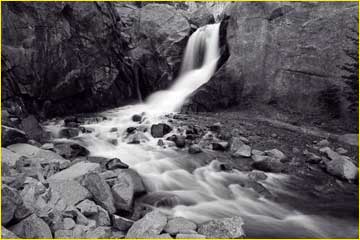
Jason Gums Chicago IL USAjasoncg@prodigy.net The picture is of Boulder Falls, just outside of Boulder CO. It was taken just after the sun rose, from a tripod using a Canon D30 with a 35-350 USM L lens. The only manipulation to the photo was a duotone via PhotoshopMichael’s Critique
The sense of motion is what makes this photograph for me. Though not quite a classic "S" curve, it’s enough to draw my eye and hold it. The strength of the rocks in the foreground nicely balance the softness of the water which was caused by a long exposure. The B&W treatment is effective as well for this composition.
You can add your own comments on Jason’s photograph on the Critique section of ourDiscussion Forum.
Gregory Goodman
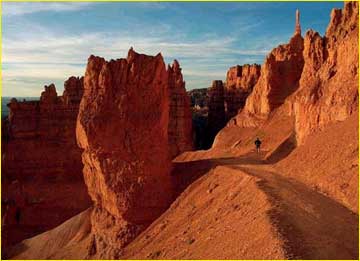
Gregory Goodman Tustin, CA USA
Michael’s Critique
Gregory hasn’t told us anything about this photograph but obviously it was taken somewhere in the American southwest‚ red rock country. It’s nicely done, but it raises an issue which I’m surprised hasn’t surfaced yet in this section. That’s whether or not to include people in a pure landscape image.
My inclination is not to, but many, including such luminaries asGallen Rowellprefer to, as it gives an image scale. What do you think? Add your comments to theDiscussion Forum.
You can add your own comments on Gregory’s photograph on the Critique section of ourDiscussion Forum.
G¸nter Haika
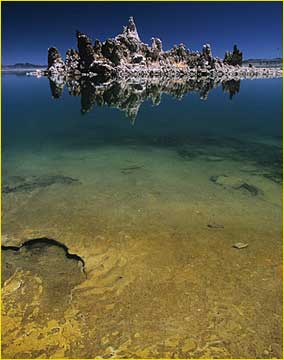
G¸nter Haika
Vienna, Austria
haika@gmx.athttp://haika.de.vu
Canon T-90, Canon FD 2,8/24, Kodachrome 25, circular polarizer. Scanned with Imacon Photo. Levels adjustment. Mono Lake morning, June 1986.
Michael’s Critique
Mono Lake is an icon of the American landscape and as such difficult to photograph with a fresh perspective. G¸nter has done an very nice job indeed in seeing this unique landscape with a fresh eye. Well seen.
You can add your own comments onG¸nter’s photograph on the Critique section of ourDiscussion Forum.
Monique Vanstone
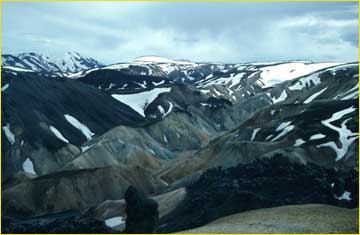
Monique Vanstone Poole, Dorset, UKmonik@ukonline.co.ukPicture taken at Landmannalaugar, Iceland on a walking holiday in a wild uninhabited part of the country cut off by snow and floods for nine months of the year. The rocks are rhyolite and black lava.
Nikon F70, Kodachrome 64 @ 80, Sigma 24-70, f11, polariser, tripod – carried on all the walks and occasionally used as a ski stick in the snow fields! Scanned in Photoshop 5 LE and levels slightly adjusted.
Michael’s Critique
Iceland seems to bring out a strong graphic sense in photographers. Monique’s photograph is a fairly straightforward record of the mountain range, but the subject matter is so stark that the image is compelling.
You can add your own comments onMonique’s photograph on the Critique section of ourDiscussion Forum.
Max Lyons
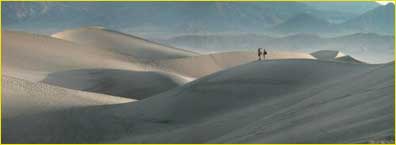
Max Lyons
Arlington, VA
maxlyons@erols.com
This image is a composite of 4 images taken with a Nikon 990 digital camera. I used Panorama Tools to warp the images and Photoshop to blend and adjust exposure between frames. As I’m sure you recognize, the picture was taken at the Mesquite Flats (Stovepipe Wells) sand dunes in Death Valley. It was taken just after dawn on March 27, 2001. Exposure: 1/60 at F5, Focal Length: approximately 220mm (35mm equivalent measure). The two shapes on the dunes are two photographers who were probably doing the same thing as me–trying to find some sand not completely covered in footprints!
Michael’s Critique
Of course I’m totally partial to this image. Anyone familiar with my site will know that a similar shot which can be found on my home page has become my signature image. How could I not include Max’s in this months critique contest?
That aside, this photograph works well. The figures add needed scale and dimension to the photograph and are well placed. My main complaint is that the colours and saturation are a bit weak, though it just might have been the light on that particular day.
You can add your own comments on Max’s photograph on the Critique section of ourDiscussion Forum.
Jed Z. Buchwald
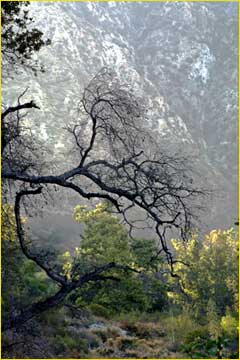
Jed Z. Buchwald
Altadena, CA
buchwald@hss.caltech.edu
I took this several days ago in Eaton Canyon in the San Gabriel Mountains, near Pasadena, at sunset. The camera is an EOS D30, 28-135mm IS lens set at 122mm, 1/20 at F/19, evalutative metering with aperture priority, 200ISO, RAW original. Processed in Phoshop 6.0 using a contrast mask.
Michael’s Critique
This image works well. Strong subject, nicely composed and interesting light. I’d be tempted to crop it a bit more aggressively. A little off the left side and a bit of the top. Hold the hair gel. Nice image!
You can add your own comments on Jed’s photograph on the Critique section of ourDiscussion Forum.
All Photographs on This Page are the Copyright of Their Respective Photographers
All Rights are Reserved
